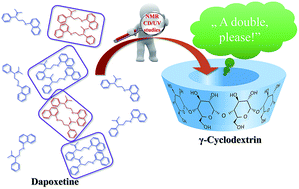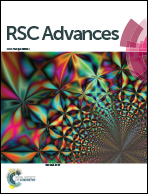NMR, CD and UV spectroscopic studies reveal uncommon binding modes of dapoxetine to native cyclodextrins†
Abstract
Complex formation between the selective serotonin reuptake inhibitor drug (S)-dapoxetine (Dpx) and β-, γ-, and methylated γ-cyclodextrins (CyDs) was studied by complementary experimental techniques. Phase solubility studies indicated 1 : 1 stoichiometry for all CyDs, with β-CyD being the most effective to enhance the solubility of and form the most stable complex with Dpx. 1H NMR titrations and Job's method of continuous variation were also employed to corroborate the stoichiometry and association constants with γ- and β-CyDs. The simultaneous evaluation of titration datasets of several Dpx and CyD protons revealed for both CyDs that the best fit was achieved when the coexistence of Dpx·CyD and 2Dpx·CyD complexes were assumed. This finding was rather unanticipated considering the smaller cavity size of β-CyD, which inspired further investigations. The UV hypochromism and circular dichroism spectroscopic data suggested the inclusion of two Dpx molecules into the CyD cavity (albeit to a less extent with β-CyD). This conclusion was fully supported by 2D ROESY and 1D NOESY NMR spectra, observing NOEs between the inner methine protons of CyDs and both the phenyl and naphthyl ring protons of Dpx. Additional molecular dynamics calculations identified the energetically most favoured species for both the Dpx·CyD and 2Dpx·CyD complexes.



 Please wait while we load your content...
Please wait while we load your content...